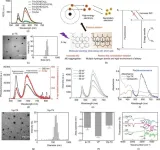(Press-News.org) Karen Della Corte, BYU nutrition and dietetics professor, recently authored a new study, published in The American Journal of Clinical Nutrition, that developed a national glycemic index (GI) and glycemic load (GL) database to offer insights into the evolving quality of carbohydrates consumed in the United States, something that hadn’t been done previously.
The GI is a scale used by public health researchers to categorize the quality of the carbohydrates. High-GI foods like white flour and sugar cereals cause a “sugar rush” that can negatively impact metabolic health. Additionally, GL factors in the quantity of carbohydrates consumed.
“Large-scale studies have shown that both high GI and GL diets are associated with an increased risk of Type 2 diabetes, cardiovascular disease, and some cancers,” said Della Corte. “In addition, high-GI foods lead to quicker hunger and increased caloric intake and contribute to weight gain.”
To conduct the study Della Corte and her husband, Dennis Della Corte, a BYU professor of physics and astronomy, developed an AI-enabled model that analyzes foods based on their GI and GL. They used the National Health and Nutrition Examination Survey (NHANES) which provided sample list of foods Americans eat daily. The AI matched the foods from the NHANES, based on the food descriptions, with their correlated GI/GL values. This created the first national GI database.
“Using open AI for the [creation] of the GI database was a novel application of ours and marks an advancement in nutritional research methodology,” said Della Corte. “Looking forward, many new and important questions can now be investigated using this database relating to the role GI and GL play for chronic disease risk in the U.S.”
This dietary database allowed Della Corte to analyze the carbohydrate intake from the data they collected from nearly 10,000 foods. A process which could have taken months was sped up and made possible using AI.
In addition to developing the methodology needed for the creation of the first national GI database in the U.S., their work includes the analysis of carbohydrate quality intake trends spanning over two decades. It reports on the top GL-contributing foods to the American diet such as soft drinks, white bread, rice and fruit juice.
“One key takeaway from this study is the importance of prioritizing low-glycemic carbohydrates in the diet. This means focusing on whole, minimally processed foods that release glucose slowly into the bloodstream and prevent spikes in blood sugar levels,” said Della Corte. “Making swaps from refined grains to whole grains can help improve the healthfulness of the diet and lower the overall dietary GI.”
Della Corte notes that having a simple understanding of what foods are low on the glycemic index can help people make more informed food choices. Think of it as turning your pantry into a “GI-friendly zone.” She suggests adding the following items to your grocery list or including some of them in weekly meal prep:
Whole grains
Beans
Lentils
Chickpeas
Brown or wild rice
Quinoa
Barley
Steel-cut or rolled oats
Non-starchy vegetables
Fruits
Nuts
Additionally, the study found dietary patterns within GI and GL based on sex, race, ethnicity, education, and income levels. Not surprising, as individuals aged, they tended to make healthier carbohydrate choices. Those with a higher education and income were more likely to eat foods with lower GI. Black adults have the highest GI/GL and women have higher GI/GL than men.
The Della Cortes say they’ve enjoyed collaborating in this research and hope their database leads to increased public awareness of the importance of carbohydrate quality, which along with other important lifestyle factors could help prevent disease and extend an individual’s health span.
“We hope that future studies derived from this database will add to the body of evidence needed to advocate for the incorporation of GI into public health guidelines and dietary recommendations.”
In addition to the Della Cortes, BYU undergraduate student Sean Titensor and Dr. Simin Liu from Brown University also contributed to this research.
END
Cracking the carb code: Researchers create new glycemic index database to improve dietary awareness
BYU researchers create the first national glycemic index database, revealing how common foods impact health and contribute to chronic diseases.
2024-07-31
ELSE PRESS RELEASES FROM THIS DATE:
Military health research reveals potential pathway to reducing youth suicide
2024-07-31
Military-connected youth that show elevated risk for suicidal ideation and suicide plans exhibit lower rates of gun-carrying, according to new research from emergency medicine faculty at the University of Colorado School of Medicine.
The analysis, published in JAMA Network Open July 31 by members of the CU Center for Combat Medicine and Battlefield (COMBAT) Researchand Firearm Injury Prevention Initiative (FIPI), offers promising insight for potentially reducing gun-carrying among youths with recent suicidal ideation or plans. Researchers are also interested in how relevant strategies in military communities ...
Cannabinoid CBG reduces anxiety and stress in first human clinical trial
2024-07-31
PULLMAN, Wash. — A lesser-known cannabinoid that is gaining in popularity Cannabigerol (CBG) effectively reduced anxiety in a clinical trial without the intoxication typically associated with whole plant cannabis. It may even have some memory enhancing effects, according to a new study in Scientific Reports.
For the study, Carrie Cuttler, an associate professor of psychology at Washington State University, and colleagues conducted the first human clinical trial investigating the acute effects of CBG on anxiety, stress and mood.
The research revealed that 20 mg of hemp-derived CBG significantly reduced feelings of anxiety at 20, ...
University hospitals nationally recognized for high-quality stroke care
2024-07-31
CLEVELAND — University Hospitals (UH) has received numerous American Heart Association Get With The Guidelines® - Stroke quality achievement awards for ensuring stroke patients receive the most appropriate treatment according to nationally recognized, research-based guidelines, ultimately leading to more lives saved and reduced disability.
Stroke is the No. 5 cause of death and a leading cause of disability in the U.S. A stroke occurs when a blood vessel that carries oxygen and nutrients to the brain is either blocked by a clot or bursts. When that happens, part of the brain cannot get the blood and oxygen it needs, so ...
Humans are born to run
2024-07-31
The 2024 Summer Olympics are in full swing. One of the marquee events is of course the marathon, a grueling test of fitness and athleticism.
When it comes to endurance running, humans are among the very top mammals in their athletic prowess. While we may not be the best sprinters in the animal kingdom, we can run steadily for long distances, even in hot weather. Our locomotor muscles are dominated by slow-twitch, fatigue-resistant fibers and our unique ability to sweat allows our bodies to effectively dissipate heat.
Humans are so good at endurance running, it seems we were born to do it. But why?
A theory of endurance
In ...
Medicaid enrollees struggle to find psychiatric care
2024-07-31
Many people enrolled in Medicaid who require psychiatric care have difficulty accessing clinicians in a timely manner despite the higher need in this population, according to a study by researchers at Weill Cornell Medicine.
The results published July 31 in JAMA found that few psychiatrists and other mental health professionals who are listed as accepting new patients enrolled in Medicaid are actually reachable and have appointments available. In cases when appointments could be made, wait times sometimes extended up to six months. The research was conducted by first author Dr. Diksha Brahmbhatt (M.D. ’24), who is now a resident physician at Brigham and Women’s ...
Smithsonian scientists devise method to secure Earth’s biodiversity on the moon
2024-07-31
New research led by scientists at the Smithsonian proposes a plan to safeguard Earth’s imperiled biodiversity by cryogenically preserving biological material on the moon. The moon’s permanently shadowed craters are cold enough for cryogenic preservation without the need for electricity or liquid nitrogen, according to the researchers.
The paper, published today in BioScience and written in collaboration with researchers from the Smithsonian’s National Zoo and Conservation ...
Revolutionary x-ray-sensitizers could transform cancer treatment with low-dose radiation therapy
2024-07-31
Researchers at Xiamen University have made a significant advancement in cancer treatment by developing a novel class of X-ray-sensitizers (XSs) that could revolutionize radiotherapy. Published in Engineering, their groundbreaking study highlights how specific organic pharmaceutical drug intermediates, derived from thioxanthone (TX), can be activated by low-dose X-rays to efficiently generate singlet oxygen for targeted cancer therapy.
Traditional radiotherapy, a cornerstone in cancer treatment, often involves high doses of radiation (typically over 50 Gy), which can lead ...
ATMs and other digital self-serve devices fail to meet accessibility needs
2024-07-31
Most self-service interactive devices — kiosks, ATMs and other digital interfaces — don't measure up to the accessibility needs of Canadians who report to have a disability, a new study has found.
In partnership with the CSA Group (Canadian Standards Association), University of Waterloo researchers interviewed people with lived experiences of disability and received an overwhelming consensus that most self-serve devices have little to no accessibility features or they have trouble finding ...
520-million-year-old worm fossil solves mystery of how modern insects, spiders and crabs evolved
2024-07-31
A new study led by researchers at Durham University have uncovered an incredibly rare and detailed fossil, named Youti yuanshi, that gives a peek inside one of the earliest ancestors of modern insects, spiders, crabs and centipedes.
This fossil dates back over 520 million years to the Cambrian period, when the major animal groups we know today were first evolving.
This fossil belongs to a group called the euarthropods, which includes modern insects, spiders and crabs. What makes this fossil so special ...
A new use for propofol in treating epilepsy?
2024-07-31
The general anesthetic propofol may hold the keys to developing new treatment strategies for epilepsy and other neurological disorders, according to a study led by researchers at Weill Cornell Medicine and Sweden’s Linköping University.
In their study, published July 31 in Nature, the researchers determined the high-resolution structural details of how propofol inhibits the activity of HCN1, an ion channel protein found on many types of neurons. Drug developers consider inhibiting HCN1 a promising strategy for treating neurologic disorders including epilepsy and chronic pain. The researchers also found, to their surprise, that when HCN1 contains ...
LAST 30 PRESS RELEASES:
What determines the fate of a T cell?
Candida auris: genetic process revealed which could be treatment target for deadly fungal disease
Groundbreaking discovery turns household plastic recycling into anti-cancer medication
Blocking a key inflammatory pathway improves liver structure and vascular function in cirrhosis, study finds
Continuous spread: Raccoon roundworm detected in nine European countries
HKUST Engineering researchers developed a novel photodetector to enhance the performance of on-chip light monitoring
Strategic river sensors could have forewarned of Texas Camp flood disaster
Drone sampling of whale breath reveals first evidence of potentially deadly virus in Arctic
Roman soldiers defending Hadrian’s Wall infected by parasites, study finds
Pinochet’s prisoners were tormented with music but still found solace in it, a new book reveals
Fertility remains high in rural Tanzania despite access to family planning
AI-assisted device can improve autism care access
Kinetic careers
Uncovering how parasitic plants avoid attacking themselves to improve crop resistance
Nanoparticle vaccine strategy could protect against Ebola and other deadly filoviruses
Study finds brain care score can predict risk of stroke across racial groups
Key lung immune cells can intensify allergic reactions
Do hormones explain why women experience more gut pain?
New materials conduct ions in solids as easily as in liquids
Breakthrough of the Year: Renewable energy begins to eclipse fossil fuel-based sources
LLM use is reshaping scientific enterprise by increasing output, reducing quality and more
Introducing LightGen, a chip for ultra-fast, ultra-efficient generative AI
Astronomers see fireworks from violent collisions around nearby star
ACC/AHA issue new guideline on managing congenital heart disease in adults
Cosmic crash caught on camera
Is talented youth nurtured the wrong way? New study shows: top performers develop differently than assumed
Ants: An untapped resource in the development of antibiotics?
Archaeologists use AI to create prehistoric video game
Mitochondria migrate toward the cell membrane in response to high glucose levels
Tiny viral switch offers hope against drug-resistant bacteria
[Press-News.org] Cracking the carb code: Researchers create new glycemic index database to improve dietary awarenessBYU researchers create the first national glycemic index database, revealing how common foods impact health and contribute to chronic diseases.



